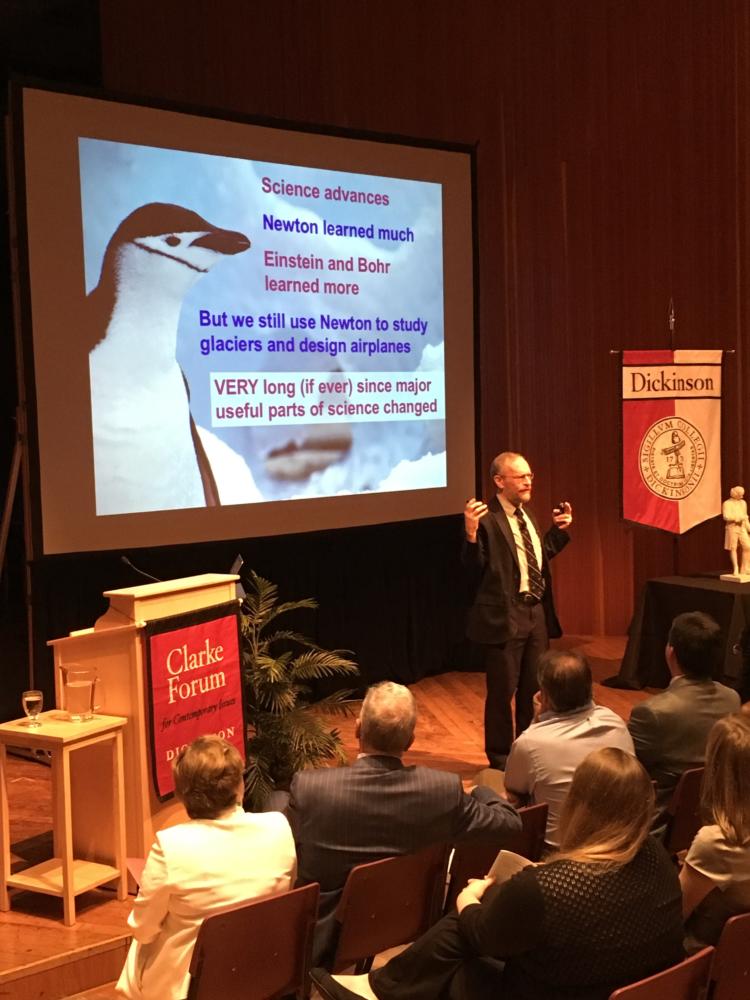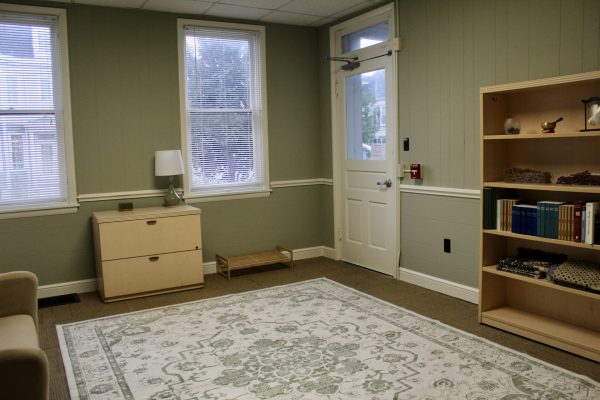Priestly Award Winner Talks Solar Energy
The 2017 Priestley Award recipient Richard Alley claimed a small portion of the Sahara Dessert would be enough to power the energy needs of all of humanity via solar energy were we to switch to solar energy instead of fossil fuels.
According to the Clarke Forum website, the Priestley award is presented “to a distinguished scientist whose work has contributed to the welfare of humanity,” in honor of Joseph Priestley, the man who discovered oxygen, who was a close friend of Dickinson founder Benjamin Rush. Alley was also presented the bronze medallion that accompanies this award.
Alley, professor of geosciences at Pennsylvania State University and winner of the 2017 Joseph Priestley Award winner, kicked off the lecture with personal photography of penguins to “lighten the mood.” He then used physics, climate models, data and history to explain the gravity of global climatic issues while providing insight and ideas on “necessary” societal change to energy and resource management.
At his talk, Alley urged Dickinson students to get involved. The generation of students currently enrolled at Dickinson are the first who know that relying on solely solar and wind for energy is a viable source for all energy needed for the future, he explained. If wind farms were put in all of the deserts and drylands it would produce five times the energy that is currently used by people. Alley presented a diagram that showed how only a small part of the Sahara Dessert would be needed to power the energy needs of all of humanity via solar energy.
He also used words from global leader Pope Francis I to highlight the importance these issues, “Climate change is an issue that can no longer be left to future generations,” expressed the pope.
Alley expressed the importance of learning ways to change away from humanity’s destructive habits of fossil fuel consumption. He said, “we must learn while we burn or burn, then learn.”
Leary, who is the Director of the Center of Sustainability at Dickinson also spoke to the fit of Alley’s talk to sustainability efforts on campus. He stated, “I think that the things that Richard Alley talked about this evening are just vitally important. These are things that are part of what Dickinson has been trying to address for a number of years.”
He then went on to discuss the relevancy of this talk to all students at Dickinson. “I think that, whatever your major is, if you were in the audience, you could find some way to connect what Richard Alley talked about to things that you are actively studying and things you think you are going to do in the future,” said Leary.
Members of the audience also appreciated the style of Alley’s presentation. Kevin Spicer, geo-environmental science teacher at Carlisle High School said, “I think that the data that he presented, the trends in that data, the graphics that he used resonated with a lot of people particularly because it was separated out from a lot of the political influence that we see today in the national news.”
Sam Weisman ’18 thoroughly enjoyed the talk. “Richard Alley,” he said, “brought energy to an often-bleak topic in his history and future of the environment. ATS [Anita Tuvin Schlecter Auditorium] was absolutely packed and Alley received a much deserved standing ovation and recognition from President Ensign as the Joseph Priestly Award Recipient,” said Weisman.
While at Dickinson, Alley also spent time in classes talking about his work and other relevant information. One class he went to was Interdisciplinary Studies 250, a course that is part of the Nepal Mosaic program. Lead by Michael Beevers, assistant professor of environmental studies Michael Fratantuono, assistant professor of international business & management and international studies and Neil Leary, director of the Center for Sustainability Education (CSE), participants of the mosaic will conduct research in Nepal for three weeks to learn about global climatic and human security issues.
Leary spoke about the experience of having Alley in his class, saying the professor “talked about how we have been hunters and gathers of energy for all of our history until now. We are still hunter gathers primarily, but we’re for the first time in the position where we can start to be farmers of energy.” He found this idea “really interesting” as he had “never heard anybody put it that way.”
Alley worked on the U.N. Intergovernmental Panel on Climate Change and is a co-recipient of the 2007 Nobel Peace Prize. Alley’s study has focused on glaciers, ice sheets and ice cores to examine and predict changes in climate such as rising sea levels and increasing global temperatures.
College President Margee Ensign expressed delight in Alley’s presence on campus through an email to The Dickinsonian, in which she wrote, “The Priestley Award is the college’s most prestigious award in science, has been awarded annually since 1952 and recipients include many Nobel Laureates. Dr. Alley is being honored for his pioneering work dealing with climate change,” said Ensign. She concluded by stating, “we are honored to have him on campus.”




